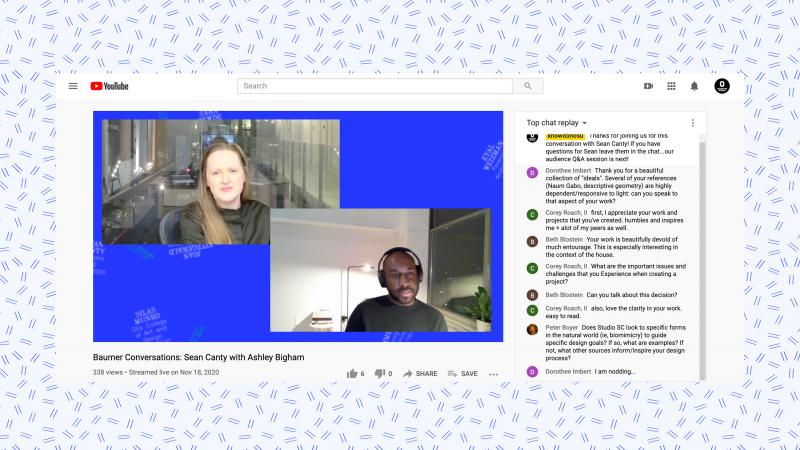Baumer Conversations: Knowlton School's Lecture Series Reimagined
Faced with the challenges posed by the pandemic and social unrest, Director of the Knowlton School Dorothée Imbert found an opportunity to reimagine the school’s hallmark lecture series. “The Baumer Lecture Series has always been a great opportunity for bringing the best designers, planners, thinkers, and innovators to the school, [but] in considering the constraints of the pandemic this year, I wanted to look at the possibility of having a series that is a bit more curated and dynamic—one that is more of an exchange than a delivery of information.”
Watch all the autumn 2020 Baumer Conversations
Imbert directed the 2020–21 Baumer Conversations Committee—Assistant Professor of Architecture Erik Herrmann, Assistant Professor of City and Regional Planning Yasuyuki Motoyama, and Assistant Professor of Landscape Architecture John Davis—to pursue a diverse lineup of presenters and topics that would allow the series to take a more current position, not only on design and planning but on what is happening in society at large.
“The model we used was the Inside the Actors’ Studio series,” said Davis, who indicated this format encourages a space where the speaker can be comfortable to speak frankly and discuss long-standing problems in the field. Following the brief guest presentation, one or two members of the Knowlton faculty engage in a directed conversation with the speaker.
“I think it is a credit to the speakers to meet the moment, and to develop timely, provocative—and often casual, immediate and accessible lectures,” said Herrmann. “And the format allows the following conversation to feel like a one-on-one exchange.”
Davis added he appreciates how the change has allowed conversations to become more collaborative and creative, “where two or more people who have thought deeply about something, say race and the American landscape, or what technology means for the future of design practice, can together come up with fresh ideas. And that this happens in real-time and can be witnessed is fantastic.”
Motoyama stated that the format's interdisciplinary approach allowed him to find areas that intersect between architects, landscape architects, and planners: “The conversation by Silas Munro is a great example. I think the conversations series gives me more concrete ideas about what I can learn from architects and landscape architects, and how we can collaborate.”

Adding to the series' conversational format, Imbert indicated to the committee it was essential that the series register the current situation. “As planners and designers we should be able to contribute to the discourse on a range of issues, from the environment to social justice, density, memory, and public space,” she said.
“It was also important to have a diversity of voices represented in the Conversations, and that can come from gender, race, background, those that work more with words, those that work more with buildings, those that are younger, those that are older,” Herrmann said. “We attempted to make sure the collection of voices in the series was diverse in as many dimensions as possible.”
For the first time in over a decade, the oversized poster that would announce the semester's Baumer Lecture Series is absent from its Knowlton Hall Center Space location. In place of the poster, the committee created a micro-site, which outlines the series’ lineup of speakers and faculty respondents, and provides details on the topics of discussion.
The motion graphics developed for the site are also used as a framing device during the public broadcasts of the series. “We decided to use the animation to make the presentation feel like more than a Zoom call. It gives the discussions a lively and dynamic background,” said Herrmann.
The series has kept its traditional 5:30 p.m. EST Wednesday time slot, although now the series is delivered as a live stream broadcast via YouTube to a public audience who can pose questions and offer comments via the chat function. Episodes of the series are also available for future viewing on the Knowlton School’s web site and YouTube channel. To tether the series to the physical presence of Knowlton Hall, faculty participants use Rm. 259—with its view of the building’s interior and South Cutout Garden—as a broadcast booth, which has been outfitted with lights, cameras, microphones, and monitors.

Several of the changes now in place for the Baumer Conversations will likely continue once in-person gatherings resume. Faculty moderators and the simultaneous live-stream broadcasts of the conversations seem likely to continue. Like Imbert, Herrmann sees the opportunity in the crisis: “What has been born due to the constraint of the pandemic will allow us to move beyond the walls of Knowlton to reach a much wider audience.”


